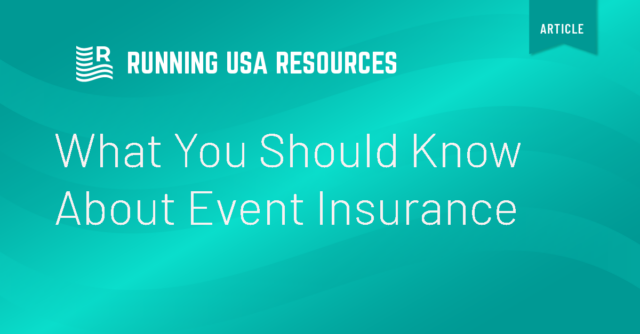By Kelly O’Mara
It’s one of those things you hope you never have to think about—but you definitely should think about before it’s too late. Actually, insurance should be one of the first things you sort out as you plan your event.
“Before they open registration, before they do anything, they really need to secure general liability insurance,” said Nathan Nicholas, president of Nicholas Hill Group, which provides event insurance to race directors and offers an insurance program discount to Running USA members.
The first thing you should be concerned about is protecting yourself and your athletes, he said, and once you figure out what kind of insurance you need, what the city or permitting agency requires, and what additional issues your event may face, then you can build the cost into your registration price and work backwards—instead of waiting until you’ve already started advertising and then realizing it’s too late.
What type of insurance do you need?
1. General liability (sometimes called event liability) is the insurance that you’ll almost definitely be required to have by your event location and/or by the permitting body (ie. the city, park district, or county). They’ll likely require you to provide a certificate or proof of insurance and name them on the policy as well.
General liability insurance is the most basic kind of insurance; it’s there to protect you, the race director. It covers your legal fees and damages up to whatever the limit is on your policy. It covers you if claims are made against you and you’re found to be negligent or liable for something going wrong. Since you’re the RD, this can encompass all manner of things you’re responsible for.
It’s important to note this does NOT cover an athlete’s own expenses if they hurt themselves due to their own fault (more on that below). This is also why it’s important to get athletes to sign a waiver, because that confirms they understand they’re responsible for entering an inherently risky event (ie. a race) and could get hurt in the regular course of the race. But that waiver doesn’t cover if something outside the realm of regular race activities goes wrong (ie. a sign falling on their head, barricades collapsing, or race officials directing them into traffic). That’s where liability insurance comes in.
2. Along with choosing what you want your limits and deductibles to be for your liability coverage, there are typically add-on insurance policies you can purchase in addition to your general liability policy. That includes a liquor liability option that expands your coverage if you’re going to have a beer garden or sell alcohol. There’s also property or equipment coverage, if you own equipment and want your property to be covered in case it gets damaged or stolen. This is similar to a business insurance policy. Running USA’s program with Nicholas Hill Group also includes a $250/year add-on to cover general liability for your office, if you have an office or staff working in an office location.
Along with variations on covering yourself in case something happens, there are also participant accident insurance or medical policies. If an athlete gets hurt, even if you’re not legally liable, this policy will pay a certain portion of their medical expenses. Running USA’s program with Nicholas Hill Group offers this as part of its general liability insurance, or you can of course purchase it elsewhere. Covering an athlete’s medical bills if they get injured at your event helps decrease the risk of you being sued, as well as being a good thing to do.
3. Directors & officers coverage—sometimes called D&O—can be important for nonprofit organizations or those with boards. It covers the individuals (officers and board members) in the event of a harassment or employment claim.
4. Event cancellation insurance has become more important in recent years and does exactly what it sounds like: it insures you if you have to cancel your event. You are not typically required to have event cancellation insurance, and many RDs will opt not to due to the cost, but Nicholas warns that event cancellations are on the rise and if you end up having to swallow the cost of an entire race being cancelled it can be exceptionally bad for business. “They don’t think it’s a mistake when they have to cancel, and then they want it,” he said.
If you have event cancellation insurance, and are forced to cancel for severe weather, terrorism, or natural disasters, then you will be reimbursed either your gross revenue, policy limit, or costs incurred (depending on your policy). Unfortunately, since the start of the COVID pandemic, communicable diseases are not currently covered.
What are your insurance options?
You can, of course, obtain event liability, equipment insurance, and business insurance through a general commercial insurance broker. You should know, though, that many of those policies will not be built for running events specifically, so be sure to read the fine print.
Another option many race directors will look into is to utilize the insurance coverage of the local nonprofit or club they operate under—for example, a YMCA. However, said Nicholas, you again need to make sure that what you’re planning to do is covered under their policy and that it doesn’t raise the organization’s overall rate.
When it comes to insuring your specific event, if you purchase event insurance you’ll be charged a rate per participant the takes into account your overall event course, length, and any risk factors. There are a handful of things that can make your insurance more expensive. For example, if it’s an ultra or 24-hour-type race, if it runs in the dark or at night, or if there are obstacles involved. These are simply things the insurance provider will take into consideration, as compared to a simple 5K around a park, when providing a quote.
In terms of obtaining race-specific insurance, you have a few options:
Running USA
Running USA offers an insurance program with Nicholas Hill Group, which is a specialized insurance broker that provides coverage for running events. Running USA members get a discount on event coverage policies. This is not a master policy where your event would then be under the umbrella; it is a discount on an individual policy specifically for your race. You can apply online, submit all of your events in one application if you choose, and get a certificate of insurance.
General liability coverage, with a $1 million policy, starts at $.15-25/participant, with a $75 minimum. Participant medical accident coverage is combined with general liability in this program, at $.10/participant. You can add equipment coverage, liquor liability, or the business/office coverage for out of event activities.
Nicholas Hill Group also offers event cancellation insurance under the Running USA program at a 10% discount.
RRCA & USATF: Both RRCA and USATF also offer insurance to their members.
RRCA (Road Runners Club of America) offers insurance to its member clubs. There is a membership fee, depending on if you’re a club or solely an event organizer. RRCA coverage only applies to RRCA members and events the members own directly.
USATF (USA Track & Field) offers event insurance coverage to USATF-sanctioned events. Check the USATF website for details.
Common insurance mistakes
OK, so the worst has happened, and you need to use that insurance you paid for and never thought about again. What now? According to Nicholas, you simply file a claim the same as you would for any insurance claim you’ve had to deal with before (auto, house). But, there are some common mistakes he says he sees event organizers make.
– Only covering the event itself. Some group policies (ie. if you run your insurance through a governing body or local nonprofit) may only cover the actual race, and not the things surrounding the race, like the expo and post-race party. In some cases, the RD is even aware of this limitation, but “sticks their head in the sand,” said Nicholas—and then they can end up regretting that.
– Not knowing all the exclusions. At times, there can be exclusions to your general event policy that you’re actually not aware of, such as for food borne bacteria, and it’s important to understand what’s covered and what’s not.
– Not buying insurance built for running races. While it is certainly possible to buy general event liability, D&O, and business insurance as standalone policies from most major insurance providers, you’re more likely to run into exclusions or complications if the policies aren’t built for running races—because what you want to cover may fall outside of the purview of traditional policies.
– Not buying cancellation insurance. Yes, it can be expensive and maybe you’ve never had an issue before, but with climate-related cancellations only on the rise and permitting agencies becoming more complicated, Nicholas said he can not emphasize enough how important cancellation insurance can end up being.
– Not building the insurance cost into the registration price. Look, we all know insurance isn’t a fun topic to plan for and you’d rather not have to spend the money (and just hope nothing bad happens). But, if you start out with insurance and then plan your budgeting backwards, then you won’t get stuck with a registration price that can’t accommodate the coverage you need.
About the Author
 Kelly O’Mara is the former editor-in-chief of Triathlete Magazine and the founder of the Triathlonish
Kelly O’Mara is the former editor-in-chief of Triathlete Magazine and the founder of the Triathlonish

